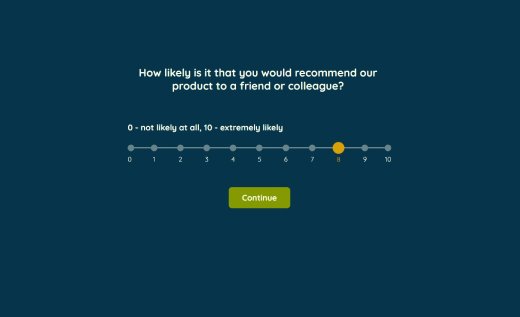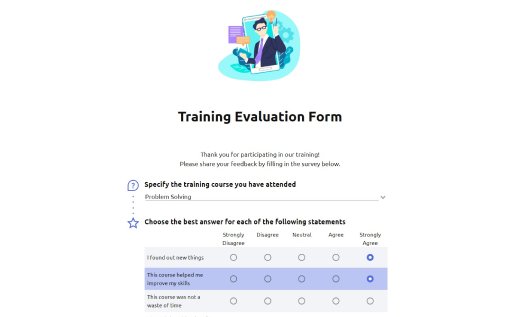Survey Rating Scale Examples

A rating scale is a type of closed-ended survey question that asks for the respondent’s feedback or opinion about some particular event, product, service, or brand. It is one of the most widely-used types of questions in almost every questionnaire and survey that we find offline or online. Survey scales may vary in how they are represented depending on the purposes and specifics of the notion under study.
Answering rating scale questions is fast and fun and when analyzed attentively, the answers provide a great deal of valuable information.
Below, I’ve placed the list of the most common survey scale examples with explanations and comments on when and how to use them in your survey. For illustration purposes, I have used rating scale samples created in the AidaForm online survey builder where you can create and use your traditional or conversational surveys free of charge.
Linear Numeric Scale
Using Linear Numeric Scales, respondents can measure such things, as their satisfaction with the quality of services provided, ease of use, importance, or likelihood to recommend. NPS (Net Promoter Score) is a specific use-case of this type. Read about Net Promoter Score.
How likely are you to recommend our product?
Graphic Scales: 1 to 5 rating scale and 1 to 10 rating scale examples
Unlike Linear Numeric Scales, the Graphic Scales may not have numbers on the scale and can ask respondents to express their satisfaction by choosing the corresponding number of graphical objects - stars, balls, cakes.
The most commonly used Graphic Scales indicate the answer options on a scale of 1 to 10 and 1 to 5. The stars and numbers represent a quantity that can be averaged and analyzed similarly to Linear Numeric Scales.
How would you rate your experience with AidaForm website?
1 - Awful, 3 - Neutral, 5 - Great
How would you rate your experience with AidaForm customer support?
1 - Awful, 10 - Great
Visual Analog / Slider Scale
The advantage of the type of scale is that respondents can choose any desired number between 0 and 100%. What is more, the slider scales are also entertaining, aren’t they?
How would you rate your experience with AidaForm customer support?
Likert Scale
The classic Likert scale asks participants to agree or disagree (or approve/disapprove) with multiple statements connected with the subject of your research. Read about the Likert Scale.
Is there the right size for a Likert scale? Your Likert scales may vary, but scales with an odd number of points are preferable, as they have a midpoint that provides participants with a neutral answer. Four or six-point scales make your respondent choose between “for” and “against.” You would love to have objective data, after all.
How strongly do you agree or disagree with the statements?
Multiple Rating Matrix
This type of rating scale is very widely used in online surveys. It looks like a compact version of four Linear Numeric Scales put together.
Please rate your attitude towards each of the brands
1 - not at all favorable, 7 - extremely favorable, N/A - I do not know the brand
Survey Templates with Rating Scale Examples
You can add these templates to your AidaForm account, customize logos and texts, and start collecting valuable business information in five minutes.
Frequency Scales
Below, you will find two examples of frequency scales that look different, but fulfill the same task — collecting information regarding frequency.
Example 1.
When purchasing electronic products, how often do you do the following?
How often do you use our product?
Choose the Most Important (Multiple Choice)
This rating scale is used when the number of answers is so big that it becomes really difficult for respondents to rate the answers using other scales. Usually, respondents are asked to choose a restricted number of choices.
Which of the following items are most important for you when you research a healthcare provider online?
You must select FIVE items
Paired Comparison Scale
A paired comparison scale is usually used for mini-ranking and asks respondents to choose between two alternatives. Paired Comparison Scale is useful to learn, for example, which website design or brand your customers like better.
Of the two websites which you visited today, which one did you prefer?
Comparative Scale/Comparative Intensity
A comparative scale asks your participants to rate their preference and strength of preference regarding the same notions of two objects of research. The online scale in the example asks respondents to rate their preference and intensity regarding two rental car tariff plans.
It can also be used to compare participants’ preferences toward a known external benchmark, such as a famous brand or website (in this example, it’s Amazon).
Example 1.
When thinking about the following attributes on the Budget and Enterprise tariff plans, which one do you prefer?
1 - Strongly prefer Budget, 3 - Neither, 5 - Strongly prefer Enterprise
It can also be used to compare participants’ preferences toward a known external benchmark such as a famous brand or website (in this example it’s Amazon).
Example 2.
In thinking about your experience on the target website comparing to Amazon.com, how would you rate the following attributes?
Semantic Differential Scale
A semantic differential scale is often used to measure emotional attitudes and beliefs. When creating the scale, it’s very important to provide clear polar opposite adjectives, like big and small. You can learn more about Semantic Differential Scales in detail in our blog post devoted to this type of survey scale.
When thinking about Netflix, how would you rate Netflix on each of the following attributes?
Adjective Checklist
Adjective checklists are widely used to assess consumers’ attitudes towards brands. It’s also the technique used in the Microsoft Desirability Toolkit to test visual appeal. Respondents have to choose from the list of adjectives, having both positive and negative connotations.
Which of the following best describes your experience with AidaForm
Semantic Distance Scale
Respondents have to rate an adjective or notions and express some level of intensity. It’s a way out when finding polar opposites on the semantic differential scale becomes really problematic.
How well the terms describe your experience with German Wings website?
1 - Not at All, 7 - Perfectly
Create Your Free Survey Using the Rating Scale Examples
Creating rating scales in AidaForm takes just a few minutes. AidaForm is an online survey maker where you can create surveys, share them, gather and evaluate responses in your member’s area.
Register for a free account and create your custom survey scales with the help of the premade Scale, Matrix, Ratings, and Multiple-choice fields or one of the ready-to-use survey templates. Add the templates you like to your AidaForm account simply by clicking the Use Template button, customize logos and texts, and start collecting valuable information right away.
What is more, AidaForm provides smart survey analysis to interpret and get the most from the data that you collected via rating scales questions.



